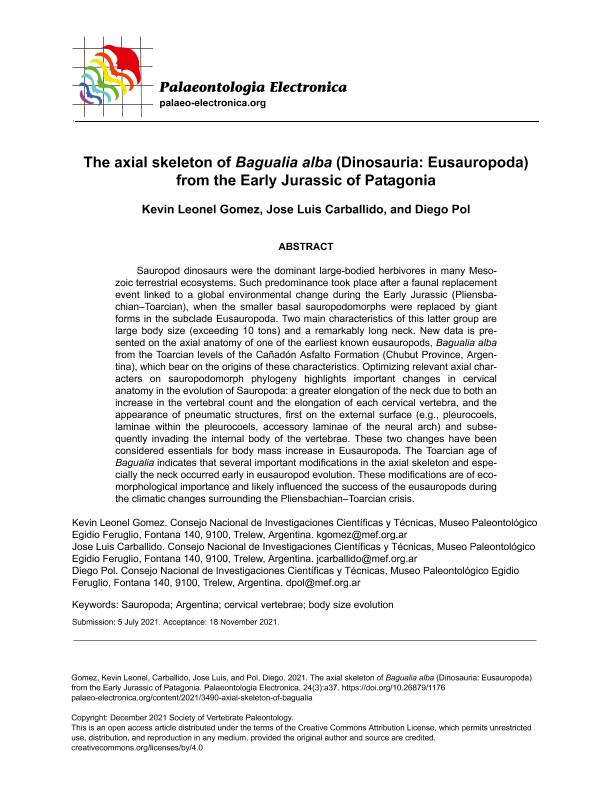Mostrar el registro sencillo del ítem
dc.contributor.author
Gomez, Kevin Leonel

dc.contributor.author
Carballido, José Luis

dc.contributor.author
Pol, Diego

dc.date.available
2022-08-29T15:34:28Z
dc.date.issued
2021-12
dc.identifier.citation
Gomez, Kevin Leonel; Carballido, José Luis; Pol, Diego; The axial skeleton of Bagualia alba (Dinosauria: Eusauropoda) from the Early Jurassic of Patagonia; Coquina Press; Palaeontologia Electronica; 24; 3; 12-2021; 1-61
dc.identifier.issn
1094-8074
dc.identifier.uri
http://hdl.handle.net/11336/166827
dc.description.abstract
Sauropod dinosaurs were the dominant large-bodied herbivores in many Mesozoic terrestrial ecosystems. Such predominance took place after a faunal replacement event linked to a global environmental change during the Early Jurassic (Pliensbachian-Toarcian), when the smaller basal sauropodomorphs were replaced by giant forms in the subclade Eusauropoda. Two main characteristics of this latter group are large body size (exceeding 10 tons) and a remarkably long neck. New data is presented on the axial anatomy of one of the earliest known eusauropods, Bagualia alba from the Toarcian levels of the Cañadón Asfalto Formation (Chubut Province, Argentina), which bear on the origins of these characteristics. Optimizing relevant axial characters on sauropodomorph phylogeny highlights important changes in cervical anatomy in the evolution of Sauropoda: a greater elongation of the neck due to both an increase in the vertebral count and the elongation of each cervical vertebra, and the appearance of pneumatic structures, first on the external surface (e.g., pleurocoels, laminae within the pleurocoels, accessory laminae of the neural arch) and subsequently invading the internal body of the vertebrae. These two changes have been considered essentials for body mass increase in Eusauropoda. The Toarcian age of Bagualia indicates that several important modifications in the axial skeleton and especially the neck occurred early in eusauropod evolution. These modifications are of ecomorphological importance and likely influenced the success of the eusauropods during the climatic changes surrounding the Pliensbachian-Toarcian crisis.
dc.format
application/pdf
dc.language.iso
eng
dc.publisher
Coquina Press

dc.rights
info:eu-repo/semantics/openAccess
dc.rights.uri
https://creativecommons.org/licenses/by/2.5/ar/
dc.subject
SAUROPODA
dc.subject
ARGENTINA
dc.subject
CERVICAL VERTEBRAE
dc.subject
BODY SIZE EVOLUTION
dc.subject.classification
Paleontología

dc.subject.classification
Ciencias de la Tierra y relacionadas con el Medio Ambiente

dc.subject.classification
CIENCIAS NATURALES Y EXACTAS

dc.title
The axial skeleton of Bagualia alba (Dinosauria: Eusauropoda) from the Early Jurassic of Patagonia
dc.type
info:eu-repo/semantics/article
dc.type
info:ar-repo/semantics/artículo
dc.type
info:eu-repo/semantics/publishedVersion
dc.date.updated
2022-08-25T13:50:13Z
dc.identifier.eissn
1532-3056
dc.journal.volume
24
dc.journal.number
3
dc.journal.pagination
1-61
dc.journal.pais
Estados Unidos

dc.description.fil
Fil: Gomez, Kevin Leonel. Consejo Nacional de Investigaciones Científicas y Técnicas; Argentina. Museo Paleontológico Egidio Feruglio; Argentina
dc.description.fil
Fil: Carballido, José Luis. Consejo Nacional de Investigaciones Científicas y Técnicas; Argentina. Museo Paleontológico Egidio Feruglio; Argentina
dc.description.fil
Fil: Pol, Diego. Consejo Nacional de Investigaciones Científicas y Técnicas; Argentina. Museo Paleontológico Egidio Feruglio; Argentina
dc.journal.title
Palaeontologia Electronica

dc.relation.alternativeid
info:eu-repo/semantics/altIdentifier/url/https://palaeo-electronica.org/content/2021/3490-axial-skeleton-of-bagualia
dc.relation.alternativeid
info:eu-repo/semantics/altIdentifier/doi/http://dx.doi.org/10.26879/1176
Archivos asociados
